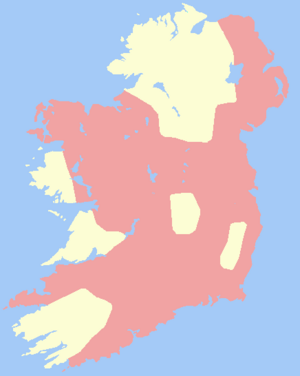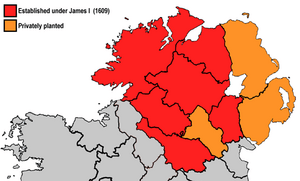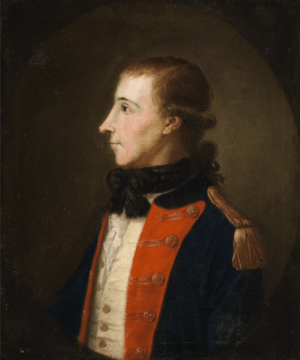British rule in Ireland facts for kids
British rule in Ireland began long ago, in the 12th century, when the Anglo-Normans arrived from England. Over many centuries, England (and later Britain) controlled parts, or all, of the island. Most of Ireland became independent from the United Kingdom after the Anglo-Irish War in the early 1900s. It first became a self-governing country called the Irish Free State in 1922. Then, in 1949, it became a fully independent country known as the Republic of Ireland. However, Northern Ireland is still part of the United Kingdom today.
Contents
Early English Rule in Ireland
Starting in the late 1100s, the Anglo-Normans took control of much of Ireland. The kings of England then said they were the rulers of Ireland. By the end of the Late Middle Ages, English control was mostly limited to a small area around Dublin. This area was known as the Pale.
In 1494, a law called Poynings' Law was passed. This law meant that the Irish parliament could not meet without permission from the English king and his advisors. In 1541, King Henry VIII of England changed Ireland's status. It went from being a "lordship" to a "kingdom," and he was declared the King of Ireland.
New Settlers and Tough Laws
In the 1500s, a process called the Plantations began. This involved settling English and Scottish Protestants in different parts of Ireland. The Ulster Plantation was a big example, where many new settlers moved to the northern area of Ulster.
Later, between 1649 and 1651, Oliver Cromwell led the Cromwellian conquest. This war led to land being taken from many Irish landowners. This land was then given to people who supported Cromwell and the English Parliament.
During the 1600s, strict rules called the Penal Laws were put in place. These laws made it very difficult for Catholics in Ireland. They couldn't own much land, get a good education, or work in certain jobs. These laws also favored the Church of Ireland, which was the official church. Even though some of these laws were later made less strict, by 1778, Catholics still owned only a small amount of land in Ireland.
Changes in the 18th and 19th Centuries
In 1798, a group called the United Irishmen tried to end British rule in Ireland. Their rebellion failed. After this, in 1800, the Act of Union was passed. This law joined the Kingdom of Ireland with Great Britain. Together, they formed the United Kingdom of Great Britain and Ireland.
In the mid-1800s, Ireland suffered terribly from the Great Famine (1845–1851). Over two million people either died or left Ireland during this time. Even though people were starving, Irish food like dairy products and wheat were still sent to Britain and other places. This was because trade was controlled by the British government.
Independence and Division
Many Irish people wanted to rule themselves. A law called the Home Rule Bill was almost passed in 1912. But World War I started in 1914, so it didn't become law. In 1916, there was an uprising called the Easter Rising. Its leaders were executed.
In the 1918 election, the Sinn Féin party won most of the Irish seats. In 1919, these elected members declared Ireland an independent Irish Republic. This led to the Irish War of Independence from 1919 to 1921.
After the war, two important agreements were made: the Government of Ireland Act of 1920 and the Anglo-Irish Treaty of 1921. These led to the creation of the Irish Free State. However, the members of parliament from Northern Ireland chose to remain part of the United Kingdom. Many countries, including the United States in 1924, recognized the Irish Free State's independence. By the 1940s, when the United Nations was formed, Ireland was seen as a full member of the world community.
See also
- History of Ireland (1169–1536), when England invaded Ireland
- History of Ireland (1536–1691), when England conquered Ireland
- History of Ireland (1691–1801), the time of the Protestant Ascendency
- History of Ireland (1801–1923), when Ireland was merged with the Kingdom of Great Britain to form the United Kingdom




